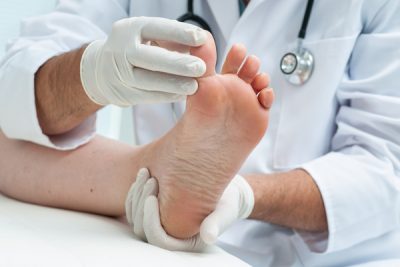
What is athlete's foot?
Athlete’s foot, also known as tinea pedis, is a fungal infection of the skin, that can occur anywhere on the foot. It can arise on moist skin, usually between the toes, effecting the fourth and fifth toes initially, or on flaky, dry skin around the heels or foot.
What causes athlete's foot?
It is caused by a number of fungal species that can be caught from someone else shedding affected skin (typically in communal areas such as changing rooms, pools and showers) or where you might walk around barefoot. It can also be passed on from direct contact from person to person.
Once the infection is established, the warm, sweaty and dark environment in trainers and shoes provides a perfect breeding ground for the fungus.
Is it serious?
In cases where the skin splits between toes, this can be a portal for infection so can be detrimental for any diabetic or any persons prone to cellulitis. If left untreated, the infection may also spread to the toenails. A nail infection is almost always a secondary event to skin infection.
The symptoms associated with athletes foot include:
- Cracked, peeling or blistered areas of the skin
- Intense itching
- Redness and scaling
- Maceration between the toes
- Athletes foot may produce few symptoms other than dry skin from which itching is often absent.
The symptoms associated with fungal nails include:
- Discolouration of the nail (yellowing, white or black)
- Thickening of the nail
- Foul smell
What can I do to treat athlete's foot?
For most cases of athletes foot simple measures are the most successful at treating the disease. Athletes foot treatments are available as:
- powders
- creams
- sprays
For where the athlete’s foot is moist (most probably in between the toes) this will require your feet to be washed in water then dried thoroughly with a separate towel. It is important not to rub your feet dry but to dab them instead. A spirit-based preparation such as surgical spirit can help by evaporating the moisture and allowing the skin to heal. Although this should not be used on broken skin.
Once symptoms have resolved, prevention is also key when managing athletes foot. .
- Change your footwear regularly. It can take 24-48 hours for shoes to dry out properly so it’s a good idea to alternate your shoes daily. If this isn’t possible then take out any insoles and loosen laces so that the air can circulate.
- Change your socks daily
- Choose shoes made from natural materials
- Wear flip flops in public areas
How do I treat fungal nails?
Fungal infections of the nails presents a significant challenge. Over-the-counter remedies such as anti-fungal nail lacquer can be used, but when taking these alone could take up to 12 months for complete resolution with no immediate noticeable results.
Where the entire nail is infected prescribed oral medications from your GP can be used for fungal nails. Combining an oral antifungal agent with a topical nail lacquer has revealed to be more effective than using an oral agent alone. Thickened nails reduces the chances of success, therefore reduction of the nails before treatment can enhance the likelihood of a positive result.
How much does the treatment cost?
Preliminary consultation, new patient examination & first treatment – £40.00
Routine consultation – £35.00
Short appointments – Nails / dressings – £20.00
Biomechanics assessment – £65.00
Orthotics / insoles – POA
